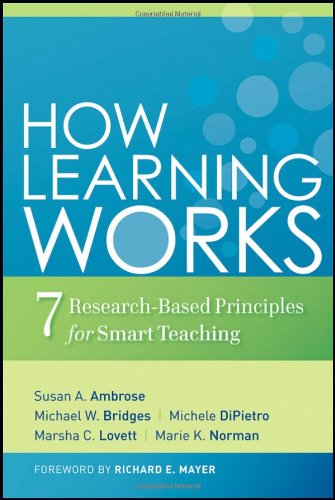7 Research-Based Principles for Smart Teaching
By Susan A. Ambrose, Michael W. Bridges, Michele DiPietro, Marsha C. Lovett, and Marie K. Norman
 We (that’s the collective “we”) know a lot about two areas that can make teaching and learning so much better:
We (that’s the collective “we”) know a lot about two areas that can make teaching and learning so much better:
- How people learn (the science of learning)
- How to help people learn (the science of instruction)
Context. Written for people who teach adults (university professors), this book has much to recommend it for teachers, trainers, and instructional designers in corporate, military, government, and healthcare settings, as well.
Readable. The writing is accessible: although based on research, never fear. They’ve done a great job of synthesizing and translating a substantial body of academic literature into readable prose.
Organization. The book is organized around seven principles about how students learn. Each one is illustrated with stories that show examples of learning problems that students often encounter. After pinpointing barriers to learning, the authors provide multiple strategies for overcoming those same barriers.
The seven principles. The authors have synthesized and organized helpful insights into these seven essential principles with the aim of helping us to make them come alive when teaching.
- Students’ prior knowledge can help or hinder learning.
- How students organize knowledge influences how they learn and apply what they know.
- Students’ motivation determines, directs, and sustains what they do to learn.
- To develop mastery, students must acquire component skills, practice integrating them, and know when to apply what they have learned.
- Goal-directed practice coupled with targeted feedback enhances the quality of students’ learning.
- Students’ current level of development interacts with the social, emotional, and intellectual climate of the course to impact learning.
- To become self-directed learners, students must learn to monitor and adjust their approaches to learning.
If you’re a designer, teacher, or trainer, I think you’ll find helpful suggestions here. For example, sometimes students’ prior knowledge gets in the way. What to do then? Or, how can you help students to become more independent and to direct their own learning? Well-researched, well-written, and centered on how we can help our learners to learn, this book is well worth having.
Resources
Book | Ambrose, et al. (2010). How Learning Works: 7 Research-Based Principles for Smart Teaching
